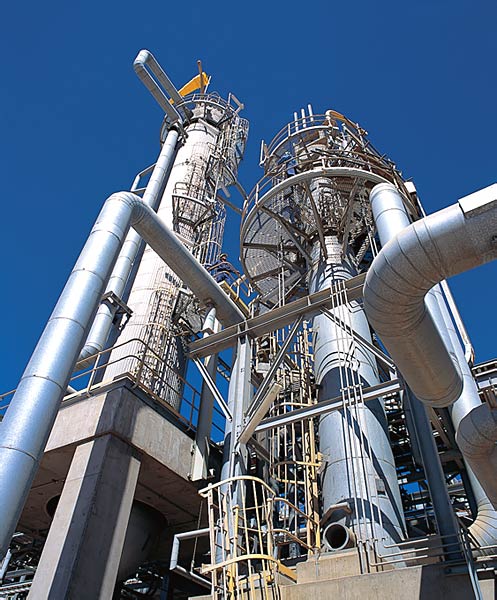Raw Materials
The major raw materials for fertilizer manufacture are hydrocarbon sources (mainly natural gas), sulfur, phosphate rock, potassium salts, micro-nutrients, water and air.
 Nitrogen
Nitrogen
The main nitrogen fertilizers manufactured include ammonia, urea, ammonium nitrate and sulfate of ammonia.
Ammonia
Ammonia is the basis for all of the major, manufactured nitrogen fertilizers. The hydrocarbon source provides a source of energy for the production of heat and compression in the manufacturing process as well as hydrogen. Water contributes hydrogen, and air is the source of nitrogen. Ammonia contains 82 % nitrogen.
Urea
Urea is manufactured by reacting ammonia with the carbon dioxide formed in the production of hydrogen in the first step of the ammonia manufacturing process. Urea contains 46% nitrogen.
Other nitrogen products
Ammonium sulfate (21% nitrogen, 24% sulfur) and ammonium nitrate (34% nitrogen) are produced by reacting ammonia with sulfuric and nitric acids, respectively. Ammonium sulfate is also produced as a by-product of a number of manufacturing processes of which nickel refiing is the most important source in Australia.
Phosphorus
Phosphate rock is the basic material used in all phosphorus fertilizer production. The most important deposits are sedimentary materials, laid down in beds under the ocean and later lifted up into land masses. Other sources are igneous, created when phosphate rich lava solidifies into rock.
Almost all phosphate rock is strip mined. It typically contains from 12-17% phosphorus and is usually upgraded for use in fertilizer manufacture. Upgrading removes clay and other impurities. This process is called beneficiation.
Following beneficiation, the phosphate rock is finely ground and treated with acid. Sulfuric, phosphoric and nitric acids are used in the production of phosphorus fertilizers.
Phosphoric Acid
Phosphate rock is treated with concentrated (90 to 93 %) sulfuric acid to produce a mixture of phosphoric acid and gypsum. Filtration removes the gypsum to leave green, wet-process or merchant grade phosphoric acid containing about 22 % phosphorus.
Potassium
Potassium deposits occur as beds of solid salts beneath the earth’s surface and brines in dying lakes and seas. These deposits are mined and then refined by crystallization or flotation.
Next